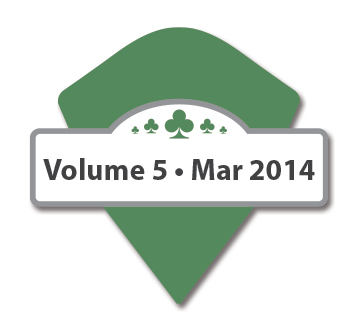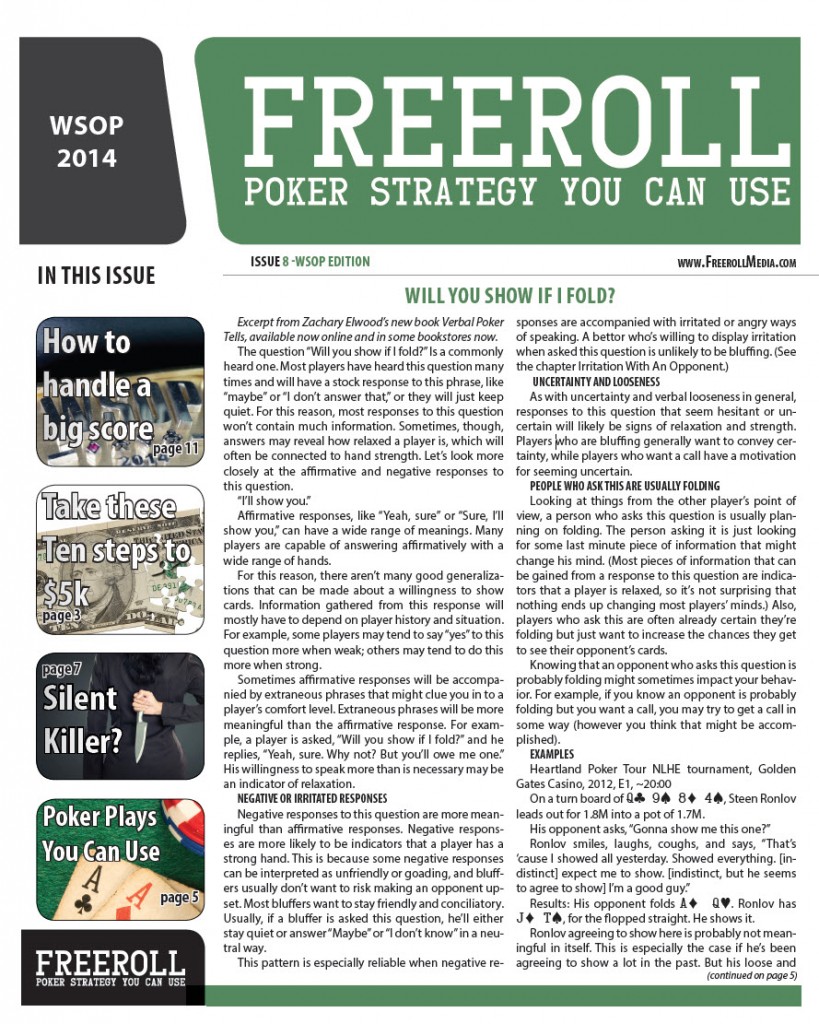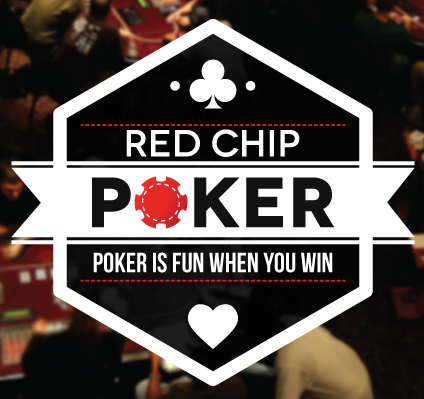Aggression and the Turn
- By Andrew Seidman
- March 20, 2014
- Comments Off on Aggression and the Turn
Let’s think about holding A♠6♠ on the 9♠7♦3♣Q♠ board. This is an ideal time to continue our flop aggression. Why? The turn card is ideal for us in many ways. First, it gives us extra pot equity—we now have twelve outs as opposed to three (as with A6o). Secondly, the Queen is an uncoordinated overcard to the board, giving us extra fold equity—the opponent is going to be more wary about continuing with a hand like 88. This combination of pot equity and fold equity is mandatory for us to stay aggressive on the turn.
Here’s a little equation to (over)simplify things a little:
POT EQUITY
+FOLD EQUITY
=AGGREASSION*
Sometimes we’ll have so much pot equity that we won’t need much fold equity. Let’s say, for example, that we have Q♥J♥ on a T♥9♥2♣4♦ board. We draw out so often on the river that we only need our opponent to fold a very low percentage of the time for a 2nd barrel to be profitable. On the other hand, let’s give ourselves 22 on an 843Ar board. Sometimes, the Ace on the turn gives us so much fold equity that our lack of pot equity (2 outs) is compensated by the fact that the opponent folds an extremely high percentage of the time. Most spots, though, aren’t as cut and dried. What if we have A♠5♠ on a 9♠7♦3♣T♠ board? Our pot equity is good, but the turn card actually decreases our fold equity, as it hits a lot of the opponent’s range. Even a hand like 88 is unlikely to fold to a turn bet because it picks up a straight draw. It’s the job of the poker player to weigh his own pot equity and fold equity to make these decisions in close spots. Once we’ve ascertained that we have a sufficient combination of pot equity and fold equity, we can continue our aggression. Usually this just means that we continue betting, as that would usually be our plan if we actually had a strong hand instead of our draw. However, in some situations it is better to go for a check-raise on the turn. What sorts of factors favor a check-raise over a second barrel?
It’s unlikely our opponent holds a strong hand. For example, say we hold A♣5♣. If we bet a wet flop—let’s say 8♣7♣4♥—and our opponent calls, we can usually be certain he doesn’t have a really powerful hand (like 88, 77, 44, 65, or 87) as he would usually raise these hands. Most of his range for calling probably includes hands like T9, J9, and A5 for straight draws; hands like 86, 76, and 55 for pairs and gutshot straight draws**; hands like A8 or 97 for weak pairs; hands like Q♣J♣ or K♣T♣ for flush draws, and hands like AJ or KQ that called simply with the intention of taking the pot away on the turn. To categorize these hands respectively, our opponent holds straight draws, pair+draws, weak pairs, flush draws, and air. Each of these hands are “floating” the flop, with the last category being considered more “pure floats” as they lack any pair or strong draw.
It’s likely that our opponent will bet a wide, weak range on the turn. [ The turn card comes a 2♦, making the board 8♣7♣4♥2♦. Let’s consider our opponent’s likely action with his range after we check the turn. With his straight draws, flush draws, and air, he’s going to bet the vast majority of the time—simply because betting is the most likely way he’s going to win the pot. He’s likely to check his weak pairs and pair+draw hands behind, as he’ll probably want to get to showdown with his weak pair.
Therefore, when he bets the turn, the vast majority of his range is very weak, and now the pot is very large. So, this becomes a good time for us to check-raise the turn as a semibluff, and of course, for Reason #3, capitalization of dead money. Sometimes, our opponent will be tricky on the flop with a hand like 65 and just call the flop. Other times, the turn card will help our opponent in a disguised way. Sometimes our opponent will hold a hand like TT, 99, A8, or 86 and decide to bet the turn and get the money in if we check-raise. To compensate for these possibilities, we need to make sure we have some equity before making this move. Thus, A♣5♣ on a 8♣7♣4♥2♥ board is perfect, as we have a ton of equity. A♣J♣ would be fine as well. K♦Q♥ probably wouldn’t be as good of an idea. Board texture is critical in understanding when to bet out and when to check-raise. If our opponent flat calls a wet board, his range generally doesn’t include monster hands like sets, two pairs, and straights. However, if our opponent calls on a dry board (let’s say 8♣6♥4♥) check-raising the turn gets significantly worse. With fewer draws available, a large portion of his turn-betting range now includes slow-played sets, two-pairs, and straights. If I had A♣5♣ on an 8♣6♥4♥2♣ board, I’d almost certainly bet the turn again and plan on folding to a raise as opposed to check-raising. Evaluating pot equity is easy: we look at how many outs we have, and through simple memorization, we know that the nut flush draw usually has between 40 and 50 percent equity. A gutshot has about 18% equity on the flop. Pretty simple. Evaluating fold equity, on the other hand, can be a lot more difficult. What factors affect our fold equity?
Player type. This is by far the most significant factor in evaluating fold equity. Against a bad player (whether bad-passive or bad-aggressive) our fold equity is greatly reduced, simply because they won’t fold very much of anything. The response is easy—we have a wider value bet range, but we can’t continue aggression with weak hands that rely on fold equity.
Board Texture. This, as we just discussed, is vital to understanding fold equity. If, on a 983r flop, an Ace lands on the turn, our fold equity will increase. If a T peels off on the turn instead, our fold equity is decreased. This part is easy to read as well—overcards increase fold equity, but low cards and coordinating cards don’t.
Number of players. This is an obvious one. If there are more hands in play, there are more cards that could’ve connected with the board, and thus our fold equity goes down.***
Image and Perceived Hand Range. We’ll go into this in greater detail in the Advanced Section, but if we have a loose and bluffy history, our fold equity decreases. If we have a tight, solid history, our fold equity increases. This is because our perceived hand range becomes either weaker or stronger.
Sometimes, these reasons play against each other. The board might be very scary on the turn when an Ace falls, but the player type is loose-passive and thus we shouldn’t continue our aggression. Other times, we’ll be in a multiway pot, but the board will be dry and they’ll both be tight players, so we’ll want to be aggressive. It’s the job of the poker player to balance these factors.
This was an excerpt from Easy Game.
*In this equation, you can think of Aggression as a constant—a magic number of combined PE and FE. So, if PE+FE don’t add up to the magic number, then you can’t be aggressive. However, sometimes you may have so much FE that you really need 0 pot equity. Bluffing the river is the most obvious example of this—there is no more pot equity because you can’t draw out on a later street. So, you’re only dealing with fold equity.
**Actually, if your opponent has a lot of those pair-plus-gutshot hands in his range, I’d usually prefer to bet three streets. You’ll nearly always get a call on the turn and a fold on the river when they miss their draw. However, if he’s aggressive enough to bet the turn, and he’ll fold to a check-raise, it’s still better to check-raise.
***This is true in that you’re playing against a strong range (i.e. 4 cards instead of 2). But, against regulars, you may be able to get them to fold better hands given the strength of your line. This is considered in the Advanced section in the chapter “Advanced Fold Equity”.



